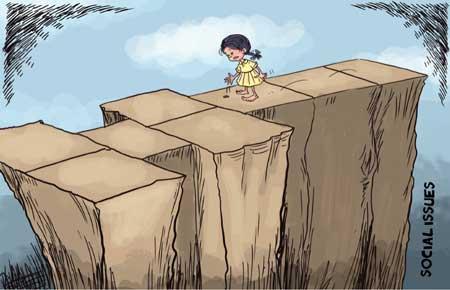01 Oct 2022 - {{hitsCtrl.values.hits}}
Famous French singer, actor and entertainer Maurice Chevalier entertained us with a beautiful song about little girls. It goes like this: “Each time I see a little girl of five or six or seven, I can’t resist a joyous urge to smile and say, thank heaven for little girls, for little girls get bigger every day, thank heaven for little girls, they grow up in the most delightful way. Those little eyes, so helpless and appealing, when they were flashing, send you crashing through the ceiling, thank heaven for little girls, thank heaven for them all, no matter where, no matter who.”
 Though this song is entertaining or somewhat romantic, the United Nations goes to a higher and deeper level when on October 11 it marks the International Day of the Girl Child. In a statement, the world body highlights the vision of the girl child—our time is now, our life, our future. The UN says that this year it marks the 10th anniversary of the International Day of the Girl Child. In these past 10 years, there has been increased attention on issues that matter to girls among governments, policymakers and the people with more opportunities for girls to have their voices heard on the global stage. Yet, investments in girls’ rights remain limited and girls continue to confront a myriad of challenges to fulfilling their potential; made worse by concurrent crises of climate change, COVID-19 and humanitarian conflict.
Though this song is entertaining or somewhat romantic, the United Nations goes to a higher and deeper level when on October 11 it marks the International Day of the Girl Child. In a statement, the world body highlights the vision of the girl child—our time is now, our life, our future. The UN says that this year it marks the 10th anniversary of the International Day of the Girl Child. In these past 10 years, there has been increased attention on issues that matter to girls among governments, policymakers and the people with more opportunities for girls to have their voices heard on the global stage. Yet, investments in girls’ rights remain limited and girls continue to confront a myriad of challenges to fulfilling their potential; made worse by concurrent crises of climate change, COVID-19 and humanitarian conflict.
Around the world, girls continue to face unprecedented challenges to their education, their physical and mental wellness, and the protections needed for a life without violence. COVID-19 has worsened existing burdens on girls around the world and worn away important gains made during the past decade. With adversity, however, comes resourcefulness, creativity, tenacity, and resilience. The world’s 600 million adolescent girls have shown time and again that given the skills and the opportunities, they can be the change-makers driving progress in their communities, building back stronger for all, including women, boys and men. Girls are ready for a decade of acceleration forward. It is time for us all to stand accountable – with and for girls – and to invest in a future that believes in their agency, leadership and potential.
Outlining the ways to get involved, the UN calls on the people to share human-interest stories, blogs and videos of girl changemakers, and the inspiring networks and organizations that are resourcing girls, letting girls lead, and strengthening services for girls. Let’s collectively amplify their leadership, actions, and impact to inspire others. We also need to engage government officials, policymakers and stakeholders to make more targeted investments that tackle inequalities experienced by girls, especially while accessing mental health and psychosocial support services in the face of conflict, forced migration, natural disasters, and the effects of climate change. The UN says we should engage key female influencers across industries to be the face of change. Role models speak a thousand words. Let’s change the global conversation and public perception of girl leaders. We also need to amplify our commitment to raising awareness about and addressing factors that hold girls in our country and region back.
Calling for Investments in the pathways to employment for adolescent girls and young women in low and middle-income countries, the UN says about 1 in 4 girls aged 15–19 globally are not in education, employment or training, compared to 1 in 10 boys. In a report, United Nations International Children’s Educational Fund (UNICEF) lays out six core investment themes and examples of investable opportunities and calls on commercial organizations and investors, with an eye on social and economic impact, to adopt bold investment approaches across these themes.
Up to 10 million girls will be at risk of child marriage. The profound effects of the COVID-19 pandemic are putting girls at higher risk of early marriage due to a combination of economic shocks, school closures and interruptions in reproductive health services. In a less developed country, almost half of primary schools have single-sex toilets – an important factor in girls’ attendance – and more than two-thirds are without electricity.
Today more than 1.1 billion girls are poised to take on the future. Every day, girls are breaking boundaries and barriers, tackling issues like child marriage, education inequality, violence, climate justice, and inequitable access to healthcare. Girls are proving they are unstoppable.
10 Jan 2025 2 hours ago
10 Jan 2025 2 hours ago
10 Jan 2025 3 hours ago
10 Jan 2025 3 hours ago
10 Jan 2025 4 hours ago